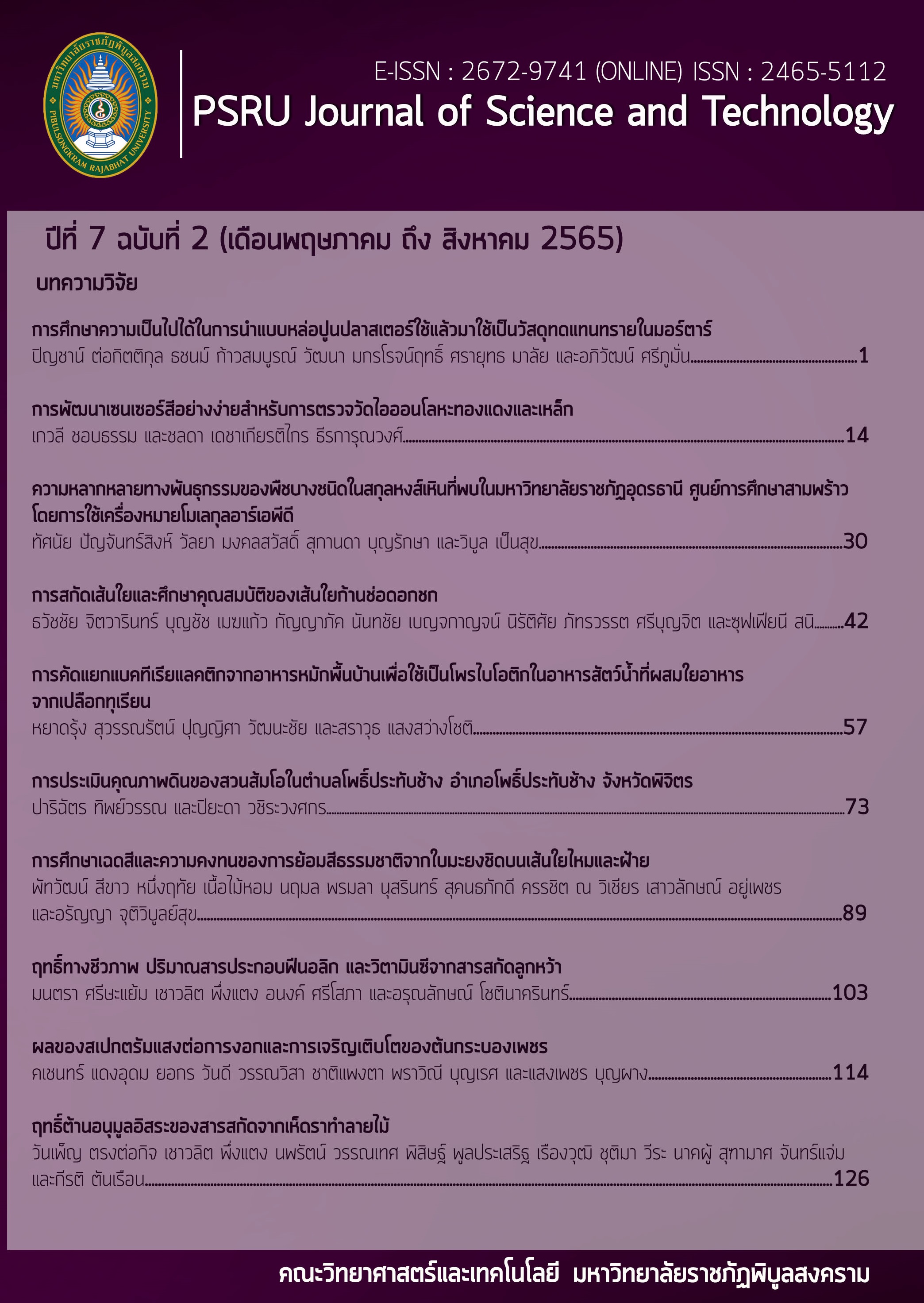BIOLOGICAL ACTIVITIES, PHENOLIC AND VITAMIN C CONTENTS FROM SYZYGIUM CUMINI (L.) EXTRACT
Keywords:
Syzygium cumini, Phenolic, Vitamin C, Antibacterial, AntioxidantAbstract
Cosmeceutical products are more attractive nowadays. Syzygium cumini fruit, a Thai fruit possess wide variety of biological activities. However, its cosmeceutical property has not reported yet. The aims of this study are to study the antioxidant activity, antityrosinase activity, inhibition of acne causing bacteria, analysis of phenolic content and vitamin C from Syzygium cumini extract. The results indicated that Syzygium cumini extract showed antioxidant activity with IC50 of 85.22±4.35 µg/ml. The phenolic content and Vitamin C of Syzygium cumini extract were 18.50±1.84 mg gallic acid equivalent/ g extract and 15.24±1.84 mg/g extract, respectively. Moreover, antityrosinase activity showed IC50 to 181.59±4.77 µg/ml. Also, Syzygium cumini extract in concentration of 50 mg/ml inhibited Propionibacterium acnes and Staphylococcus aureus to 1.45±0.07 cm and 0.95±0.50 cm, respectively. Therefore, Syzygium cumini extract can be further developed for cosmeceutical products. However, skin irritation should be evaluated.
References
กิติพงศ์ อัศตรกุล, และนฤมล หิมะสุทธิเดช. (2560). ฤทธิ์การต้านอนุมูลอิสระและฤทธิ์การยับยั้งการเจริญของแบคทีเรียของสารสกัดจากหัวหอมและการประยุกต์ใช้ในน้้าผักและผลไม้ผสม. วารสารเทคโนโลยีการอาหาร มหาวิทยาลัยสยาม, 12, 71-83.
นิตยา บุญนำมา, ณัฏฐา เลาหกุลจิตต์ม, ฉัตรภา หัตถโกศล, และพร้อมลักษณ์ สมบูรณ์ปัญญากุล. (2558). การเอนแคปซูเลชั่นน้ำลูกหว้าด้วยการแห้งทำแบบพ่นฝอยและผลต่อสมบัติทางเคมี-กายภาพปริมาณสารออกฤทธิ์ทางชีวภาพ และประสิทธิภาพการต้านอนุมูลอสิระ. วารสารวิทยาศาสตร์เกษตร, 46(3)(พิเศษ), 601-604.
ปฏิวิทย์ ลอยพิมาย, ทิพวรรณ ผาสกุล, และราตรี มงคลไทย. (2554). เปรียบเทียบฤทธิ์การต้านอนุมูลอสิระ และสารประกอบฟีนอลิกรวมของเปลือกผลไม้. วารสารวิทยาศาสตร์เกษตร, 42(2)(พิเศษ), 385-388.
ประไพพิศ อินเสน. (2561). การยับยั้งกระบวนการสร้างเม็ดสีเมลานินจากพืชกลุ่มเบอร์รีไทย. วารสารวิชาการมหาวิทยาลัยอีสเทิร์นเอเชีย, 12(2), 69-82.
ศรีปาน เชยกลิ่นเทศ, ทศพร นามโฮง, และกลอยใจ เชยกลิ่นเทศ. (2556). ผลของการเตรียมเนื้อลําไย เงาะและลิ้นจี่ก่อนการอบแห่งด้วยไมโครเวฟรร่วมกับอินฟราเรดตามด้วยลมร้อนต่อปริมาณน้ําตาลและฤทธิ์ต้านอนุมูลอิสระ. วารสารวิชาการ มทร.สุวรรณภูมิ, 1(2), 115-127.
ศิริวรรณ แก้วเพ็ชร์, สุณีนุช คุ้มภัย, สุรัตน์ โหนา, และอลิษา โต๊ะและ. (2553). การศึกษาสารสกัดจากพืชในการยับยั้งการเจริญเติบโตของเชื้อแบคทีเรียที่เป็นสาเหตุการเน่าเสียของเนื้อสัตว์. (รายงานการวิจัย). ปทุมธานี: มหาวิทยาลัยเทคโนโลยีราชมงคลธัญบุรี.
สุภาณี ฟ้ารุ่งสาง, และอนุศรา พิพัฒน์พิทยาสกุล. (2554). การพัฒนาเจลจากผลหว้าเพื่อใช้รักษาแผลในปาก. (ปริญญาเภสัชศาสตรบัณฑิต). มหาวิทยาลัยมหิดล, คณะเภสัชศาสตร์.
Afify, A.M.R., Fayed, S.A., Shalaby, E.A.,& El-Shemy, H.A. (2011). Syzygium cumini (pomposia) active principles exhibit potent anticancer and antioxidant activities. Afr J Pharm Pharmacol, 5, 948-956.
Aramwit, P., Bang, N., & Srichana, T. (2010). The properties and stability of anthocyanins in mulberry fruits. Food Res Int, 43, 1093-1097.
Arash, M., Jinous, A., Parisa, S., & Mehrdad, F. (2015). Total phenolic and flavonoid content and antibacterial activity of Punica granatum L. var. pleniflora flowers (Golnar) against bacterial strains causing foodborne diseases. BMC Complement Altern, 15, 366.
Benherlal, P.S., & Arumughan, C. (2007). Chemical composition and in vitro antioxidant studies on Syzygium cumini fruit. J Sci Food Agric, 87, 2560-2569.
Borges, A., Ferreira, C., Saavedra, M.J., & Simoes, M. (2013). Antibacterial activity and mode of action of ferulic and gallic acids against pathogenic bacteria. Microb Drug Resis, 19(4), 256-65.
Jain, M.C., & Seshadri, T.R. (1975). Anthocyanins of Eugenia jambolana fruits. Indian J Chem, 3, 20-23.
Junlatat, J., Fangkrathok, N., & Sripanidkulchai, B. (2018). Antioxidative and melanin production inhibitory effects of Syzygium cumini extracts. Songklanakarin J. Sci. Technol, 40 (5), 1136-1143.
Kim, Y.J. (2007). Anti-melanogenic and antioxidant properties of gallic acid. Biol Pharm Bull, 30, 1052-1055.
Lewis, Y.S.,Dwarakanath, C.T.,& Johar, D.S. (1956). Acids and sugars in Eugenia jambolana. Journal of Scientific and Industrial Research, 15C, 280-281.
Rahman, M.M., & Hosin, M.M. (2007). Analysis of Vitamin C (ascorbic acid) Contents in Various Fruits and Vegetables by UV-spectrophotometry, Bangladesh. J Sci Ind Res, 42, 417-424.
Ramanuj, K., Bachani, P., & Kothari, V. (2012). In vitro antimicrobial activity of certain plant products / seed extracts against multidrug resistant Propionibacterium acnes, Malassezia furfur, and aflatoxin producing Aspergillus flavus. Research in Pharmacy, 2(3), 22-31.
Sanadi, R.M., & Deshmukh, R.S. (2020). The effect of Vitamin C on melanin pigmentation – A systematic review. Journal of Oral and Maxillofacial Pathology, 24(2), 374–382.
Santos, J., La, V.D., Bergeron, C., & Grenier, D. (2011). Inhibition of host- and bacteria-derived proteinases by natural anthocyanins. J Periodont Res, 46(5), 550-557.
Sapkota, K., Park, S.E., Kim, J.E., Kim, S., Choi, H.S., Chun, H.S., & Kim, S.J. (2010). Anti-oxidant and antimelanogenic properties of chestnut flower extract, Biosci Biotechnol Biochem, 74, 1527–1533.
Sari, P., Wijaya, C.H., Sajuthi, D., & Supratman, U. (2012). Color properties, stability, and free radical scavenging activity of jambolan (Syzygium cumini) fruit anthocyanins in a beverage model system: Natural and copigmented anthocyanins. Food Chem, 132, 1908-1914.
Sharma, S.R., Poddar, R., Sen, P., & Andrews, J.T. (2008). Effect of vitamin C on collagen biosynthesis and degree of birefringence in polarization sensitive optical coherence tomography (PS-OCT). African Journal of Biotechnology, 7(12), 2049-2054.
Singh, J., Shukla, R.K., & Walia, S. (2013). Sugar profile, total phenolic and antioxidant potential of anthocyanins rich Syzygium cumini fruit. NPAIJ, 9(9), 350-354.
Singleton, V.L., Orthofer, R. & Lamuela-Raventos, R.M. (1999). Analysis of total phenols and other oxidation substrates by means of Folin-Ciocalteu reagent, Methods in Enzymology, 299, 152–178.
Srisayam, M., & Chantawannakul, P. (2010). Antimicrobial and antioxidant properties of Thai honeys produced by Apis mellifera in Thailand. Journal of ApiProduct and ApiMedical Science, 2(2), 77-83.
Srisayam, M., Weerapreeyakul, N., Barusrux, S., & Kanokmedhakul, K. (2014). Antioxidant, antimelanogenic, and skin-protective effect of sesamol. Journal of cosmetic science, 65, 69-79.
Traber, M.G., & Stevens, J.F. (2011). Vitamins C and E: Beneficial effects from a mechanistic perspective. Free Radic Biol Med, 51(5), 1000–1013.
Utharalakshmi. N., Gayathri. S., Hansika. S., & Narendrakumar. G. (2020). Unlocking the Therapeutic Potential of Syzygium cumini Seeds Extract. Current Trends in Biotechnology and Pharmacy, 14 (4), 403-414.
Zhang, L.L., & Lin, Y.M. (2009). Antioxidant tannins from Syzygium cumini fruit. Afr. J. Biotechnol, 8, 2301–2309.
Downloads
Published
How to Cite
Issue
Section
License
Copyright (c) 2022 PSRU Journal of Science and Technology

This work is licensed under a Creative Commons Attribution-NonCommercial-NoDerivatives 4.0 International License.
กองบรรณาธิการขอสงวนสิทธิ์ในการปรับปรุงแก้ไขตัวอักษรและคำสะกดต่างๆ ที่ไม่ถูกต้อง และต้นฉบับที่ได้รับการตีพิมพ์ในวารสาร PSRU Journal of Science and Technology ถือเป็นกรรมสิทธิ์ของคณะวิทยาศาสตร์และเทคโนโลยี มหาวิทยาลัยราชภัฏพิบูลสงคราม และ
ผลการพิจารณาคัดเลือกบทความตีพิมพ์ในวารสารให้ถือมติของกองบรรณาธิการเป็นที่สิ้นสุด







